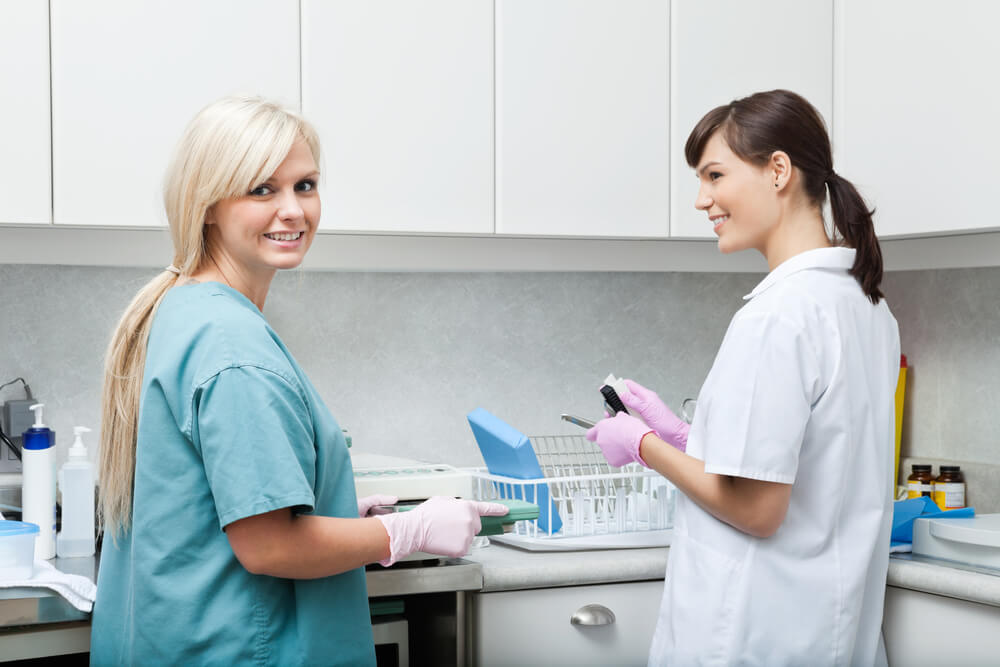The temperature to sterilise is an essential part of many different dental offices. There are various temperatures at which instruments are sterilised, each with its advantages and disadvantages. This blog post will discuss the different types of temperatures to sterilise and how they are used for various dental instruments.
Dry heat sterilisation: time, temperature, types & uses
The dry heat sterilisation process is one of the most common methods to sterilise dental instruments. It uses saturated steam to kill microorganisms. This sterilisation is typically done using an autoclave, which uses steam to sterilise equipment.
Autoclaves use gravity or pre-vacuum cycles to remove air from the chamber before beginning the heating process. Gravity cycles rely on weight and pressure differences to remove air from the chamber, while pre-vacuum cycles use pumps to create a vacuum before starting the cycle.
The dry heat sterilisation process is accomplished by conduction, where the exterior surface of an item absorbs heat and is then passed inward to the next layer. Eventually, the entire item reaches the proper temperature needed to achieve sterilisation. The temperature for dry heat sterilisation is between 160-180 degrees Celsius. The time required for sterilisation using dry heat depends on the temperature, typically between 60-90 minutes.
Dry heat sterilisation is a slower process than other methods of sterilisation. Still, it has the advantage of sterilising items that are temperature sensitive or unable to withstand exposure to moisture.
What is autoclave sterilisation?
Autoclave sterilisation is a process that uses heat penetration to sterilise equipment and instruments. This type of sterilisation is effective in killing microorganisms, including bacteria and viruses. Autoclaves use gravity or pre-vacuum cycles to remove air from the chamber before beginning the heating process.
Plastic Polypropylene is an inexpensive resin that can resist autoclave temperatures. Polypropylene containers are often used as secondary containers to hold autoclaved materials. Polycarbonate can also withstand high temperatures.
What are the benefits of autoclave sterilisation?
Autoclave sterilisation has many benefits, including that it is effective in killing microorganisms quickly and does not require using chemicals.
What are the disadvantages of autoclave sterilisation?
Some disadvantages of steam sterilisation include damaging delicate instruments and requiring special training.
Eto sterilization: time, temperature & uses
ETO sterilisation is a type of gas sterilisation that uses ethylene oxide gas to kill microorganisms. ETO sterilisation effectively kills bacteria, viruses, fungi, and spores. This sterilisation typically occurs at temperatures between 35-37 degrees Celsius and relative humidity levels between 30-40%.
The time and temperature are two important factors in EtO sterilisation. The time required for sterilisation depends on ethylene oxide gas’s temperature, humidity, and concentration.
What is ethylene oxide?
Ethylene oxide is a colourless, flammable gas used in various industries, including as a fumigant and sterilant.
The benefits of EtO sterilisation include that it is effective in killing microorganisms, does not require chemicals, and can be used to sterilise heat-sensitive equipment.
What are the disadvantages of Eto sterilisation?
There are some disadvantages of EtO sterilisation, including that it is flammable, it is corrosive, and it can be toxic.
Gamma Sterilization: Time, Temperature & Uses
Gamma rays are a type of ionising radiation that is emitted from radioactive materials. Gamma sterilisation is radiation sterilisation that uses gamma rays to kill microorganisms. Gamma sterilisation effectively kills bacteria, viruses, fungi, and spores. This sterilisation typically occurs at temperatures between -20 and -60 degrees Celsius.
The time required for gamma sterilisation depends on the temperature and radiation dose.
What are the benefits of gamma sterilisation?
The benefits of gamma sterilisation include that it is effective in killing microorganisms, does not require chemicals, and can be used to sterilise heat-sensitive equipment.
What are the disadvantages of gamma sterilisation?
There are some disadvantages of gamma sterilisation, including that it can damage delicate instruments, require special training, and harm people if not used properly.
Requirements for autoclaving
There are three requirements for autoclaving: time, temperature, and pressure. The time and temperature required for sterilisation vary depending on the type of microorganism being killed.
You should understand temperature and time requirements during the sterilisation process. It is to help you understand the importance of using the right equipment. Knowing about these things can save you from purchasing either unsuitable equipment or not working correctly.
Pressure is also an essential factor in autoclaving. Autoclaves use gravity or pre-vacuum cycles to remove air from the chamber before beginning the heating process. Autoclaves operate at high temperatures and pressure to kill microorganisms and spores. They decontaminate certain biological waste and sterilise media, instruments, and labware.
Moist heat sterilisation
It is the process of using steam to kill microorganisms. Moist heat sterilisation typically occurs at temperatures between 121-134 degrees Celsius.
The time required for moist heat sterilisation depends on the temperature and the type of microorganism being killed.
What are the benefits of moist heat sterilisation?
The benefits of moist heat sterilisation include that it is effective in killing microorganisms, does not require chemicals, and can be used to sterilise heat-sensitive equipment.
How do you sterilise with an autoclave?
To sterilise with an autoclave:
- Remove all air from the chamber using either a gravity or pre-vacuum cycle.
- Set the temperature and time required for sterilisation.
- Start the cycle and allow it to run until completion.
Biological indicators (BIs) in autoclave validation
Biological indicators (BIs) validate that an autoclave is working properly. BIs are spores that are resistant to sterilisation. Biological indicator vials contain spores from B.stearothermophilus, a microorganism that is inactivated when exposed to 121.1 o C saturated steam for a minimum of 20 minutes. Autoclaves used to treat biological waste will be evaluated with a biological indicator by EHS every quarter. To use a BI, place it in the autoclave with your load and run a cycle as you would normally. After the process is complete, incubate the BI for 24-48 hours. If the BI germinates, the autoclave is ineffective in killing all spores and needs to be recalibrated.
Additionally, biological indicators are viable microorganisms. These microorganisms are resistant to sterilisation processes, enabling monitoring of whether the required sterilisation conditions are met when eradicating the undesirable microbes present.
Precautions when using an autoclave
Some precautions need to be taken when using an autoclave:
- Make sure that the autoclave is properly calibrated before each use.
- Do not overload the autoclave.
- Do not use flammable materials in the autoclave.
- Make sure that the area around the autoclave is well-ventilated.
Autoclaves are most commonly used in the healthcare industry to sterilise medical instruments. Autoclaves can also sterilise laboratory equipment, food, and pharmaceuticals.
What is the minimum temperature for sterilisation?
The minimum temperature for sterilisation in an autoclave is 121.11°C (250°F). Autoclaves use steam to sterilise equipment and supplies by killing microorganisms. The high temperature and pressure inside the autoclave chamber make it possible to kill bacteria, viruses, fungi, and spores.
What is the difference between sanitising and sterilising?
Sanitising is the process of reducing the number of microorganisms on a surface to a safe level. Sterilising is the process of killing all microorganisms on a surface.
References
https://www.webmd.com/a-to-z-guides/what-to-know-about-aseptic-technique


